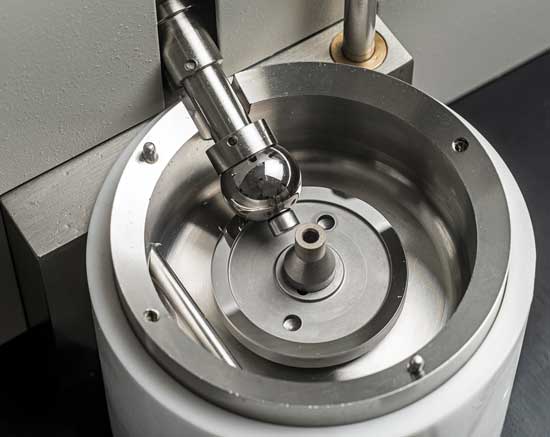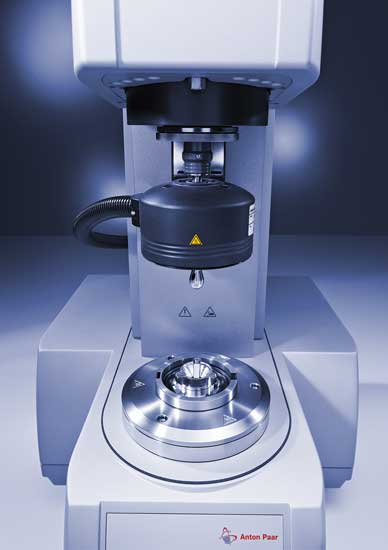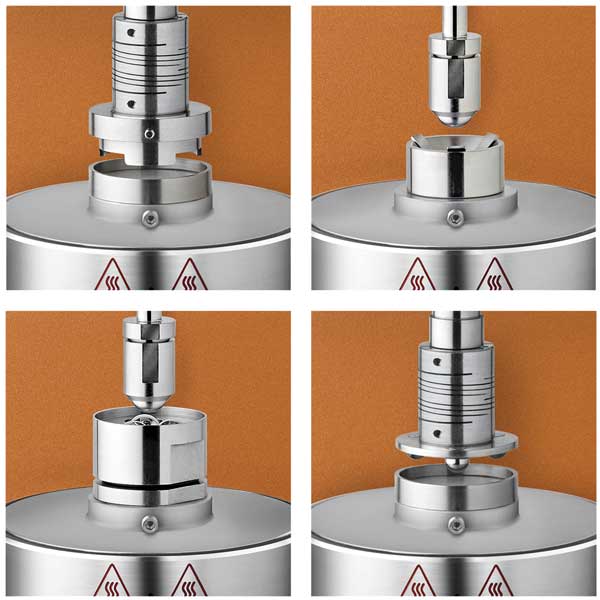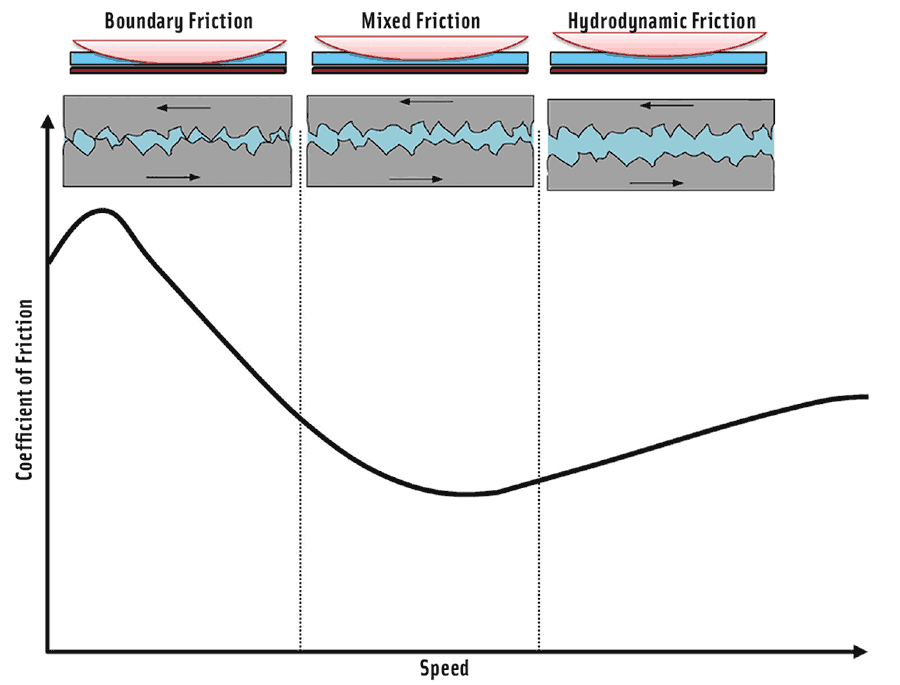Fact or Friction: Characterizing Food by Tribology
FOOD SAFETY & QUALITY
Rheology has been used for many years to characterize the flow properties of foods and beverages, and rheological measurements have been well correlated with results of sensory evaluation. While rheology has been used for many decades, tribology—the science and technology related to friction, lubrication, and wear—has been applied to food only more recently. Tribology is concerned with quantifying the coefficient of friction as a function of sliding speed and normal load under dry or lubricated conditions. It is being applied not only to lubrication of industrial manufacturing surfaces (bearings, coatings, etc.) but also to biological applications, among them orthopedics, dentistry, personal care, and oral processing (eating and drinking). The biological approach is sometimes referred to as bio-tribology or soft tribology.
During oral processing, a rounded mass of the food (i.e., a bolus) is formed, mixed with saliva, and swallowed. These processes are affected by the flow and frictional properties of the food in the mouth. Rheology provides information about the flow, deformation, and fracture properties of food, and tribology provides information about the frictional interactions of food with the surfaces of the tongue, palate, and teeth. Mouthfeel attributes such as creaminess or roughness and astringency have been linked to friction on the tongue and palate, and friction screening tests are becoming increasingly used in product development.
Tribology Instruments
Instruments for tribology traditionally involve the use of hard surfaces, such as stainless-steel balls and plates, but for food purposes soft surfaces representing the tongue and palate are being developed and used. There are two basic types of instruments for measuring tribology: 1) instruments designed specifically to measure friction and 2) rheometers with attachments for measuring friction, allowing measurements of rheological and tribological properties on a single device. Both types of instrument report friction data as Stribeck curves of friction coefficient vs sliding speed, showing the frictional behaviors of films of lubricant formed between the two surfaces. As the measurement proceeds, various areas, or regimes, of friction between the surfaces can be identified, including boundary friction (significant surface-to-surface contact), mixed friction (reduced surface-to-surface contact), and elastohydro-dynamic friction (full surface separation by the lubricant). While hydrodynamic forces dominate at high speeds to keep surfaces apart, as the speed decreases so does the film thickness and friction until surfaces are in close proximity. The friction then increases in the mixed regime with further decreases in speed until a plateau region is observed (boundary regime). Instruments from three companies are the most widely used for tribological measurements of foods and beverages.
 PCS Instruments Ltd., London, United Kingdom (pcs-instruments.com), offers the Mini Traction Machine (MTM), which has been used for more than 100 papers on the fundamentals and application of tribology to food, including studying tongue-palate interaction, mouthfeel, and food texture of foods such as yogurt, cream, mayonnaise, chocolate, and candy and determining astringency of wine, tea, and fruit. The MTM and its newer version, the MTM2, measure the frictional properties of lubricated and nonlubricated contacts under a wide range of rolling and sliding conditions. A ball and disc, made from a range of hard and soft materials, depending on the application, are loaded against one another and driven independently to create a mixed rolling/sliding contact, producing a range of traction measurements across all three lubrication regimes. A force transducer measures the frictional force between the ball and disc, and additional sensors measure the applied load, the lubricant temperature, and the relative wear between the ball and the disc. The company will launch in 2017 its Bio-Tribology Machine, designed specifically for soft-contact applications.
PCS Instruments Ltd., London, United Kingdom (pcs-instruments.com), offers the Mini Traction Machine (MTM), which has been used for more than 100 papers on the fundamentals and application of tribology to food, including studying tongue-palate interaction, mouthfeel, and food texture of foods such as yogurt, cream, mayonnaise, chocolate, and candy and determining astringency of wine, tea, and fruit. The MTM and its newer version, the MTM2, measure the frictional properties of lubricated and nonlubricated contacts under a wide range of rolling and sliding conditions. A ball and disc, made from a range of hard and soft materials, depending on the application, are loaded against one another and driven independently to create a mixed rolling/sliding contact, producing a range of traction measurements across all three lubrication regimes. A force transducer measures the frictional force between the ball and disc, and additional sensors measure the applied load, the lubricant temperature, and the relative wear between the ball and the disc. The company will launch in 2017 its Bio-Tribology Machine, designed specifically for soft-contact applications.
 Anton Paar USA, Ashland, Va. (anton-paar.com), makes the MCR Tribometer, based on the company’s Physica Modular Compact Rheometer (MCR) but featuring an accessory that allows the instrument to not only measure bulk rheological properties but also become a fully functional tribometer. The tribometer setup consists of a holder for a half-inch ball and a bottom stage clamping three friction plates. The rheological data collected characterize viscosity and yield behavior, which can be correlated to texture and appearance, and the tribometer produces Stribeck curves, showing differences in the lubrication properties that can be related to creaminess and lubricity. In addition to the ball-on-three-plates system, the company also offers a pins-on-disc system on a Peltier base with such contact geometries as flat-on-flat, point-on-flat, line contact, and others as well as customized setups such as a bearing option, a four-ball option, and an O-ring setup. It has also developed a microscopy platform, which helps in visualization of the contact during the test and a nano-tribometer for nanoscale applications.
Anton Paar USA, Ashland, Va. (anton-paar.com), makes the MCR Tribometer, based on the company’s Physica Modular Compact Rheometer (MCR) but featuring an accessory that allows the instrument to not only measure bulk rheological properties but also become a fully functional tribometer. The tribometer setup consists of a holder for a half-inch ball and a bottom stage clamping three friction plates. The rheological data collected characterize viscosity and yield behavior, which can be correlated to texture and appearance, and the tribometer produces Stribeck curves, showing differences in the lubrication properties that can be related to creaminess and lubricity. In addition to the ball-on-three-plates system, the company also offers a pins-on-disc system on a Peltier base with such contact geometries as flat-on-flat, point-on-flat, line contact, and others as well as customized setups such as a bearing option, a four-ball option, and an O-ring setup. It has also developed a microscopy platform, which helps in visualization of the contact during the test and a nano-tribometer for nanoscale applications.
 TA Instruments–Waters, New Castle, Del. (tainstruments.com), offers its Discovery Hybrid Rheometer with Tribo-Rheometry accessories, including ring-on-plate, three-balls-on-plate, ball-on-three-plates, and four-ball systems, each available with temperature control. The instruments bring two surfaces into contact, control the load force, and then apply rotational motion to one of the surfaces. Software calculates and displays relevant variables such as the coefficient of friction, load force, and sliding speed that can be used to construct Stribeck curves. The instruments can make static friction measurements or explore specific combinations of temperature, contact force, and motion.
TA Instruments–Waters, New Castle, Del. (tainstruments.com), offers its Discovery Hybrid Rheometer with Tribo-Rheometry accessories, including ring-on-plate, three-balls-on-plate, ball-on-three-plates, and four-ball systems, each available with temperature control. The instruments bring two surfaces into contact, control the load force, and then apply rotational motion to one of the surfaces. Software calculates and displays relevant variables such as the coefficient of friction, load force, and sliding speed that can be used to construct Stribeck curves. The instruments can make static friction measurements or explore specific combinations of temperature, contact force, and motion.
Status and Challenges
Helen Joyner, assistant professor, University of Idaho, whose research focuses on relating tribological behavior of foods to rheological and sensory behavior and how incorporation of saliva affects the tribological behavior of food, said that although a few companies in the food industry, particularly larger companies, are using tribology, the food industry is still becoming aware of tribology and its potential applications for determining how food friction affects functional properties and sensory attributes. Researchers are investigating mouthfeel terms related to friction, such as astringency, mouth coating, slipperiness, sliminess, and any tactile sensation that may be able to be described as friction-dominated. What needs to be done to increase the use of tribology in the food industry, she said, is to first make people aware of what it is and what it can tell us about food that other techniques cannot and to develop fundamental research on how food structure, composition, and physicochemical properties affect tribology. For example, understanding the role that fat and fat replacers play in food friction behavior can help food companies understand why certain reduced-fat formulations are acceptable to consumers and others are not.
Joyner added that researchers need to continue working to develop testing surfaces that truly mimic the oral surface and to interpret what the friction behavior curve means with regard to structure in terms of sensory evaluation. The best approach for product development, she said, is to do both a normal rheological study and a tribological study. Tribology gives information that traditional rheological testing methods can’t provide, painting a clearer picture instrumentally of what happens when food is chewed and swallowed and filling in some of the gaps in knowledge.
Stefan Baier, associate R&D fellow, PepsiCo Inc., said that tribology is an important technique in understanding texture and mouthfeel and is becoming more popular, but increasing its use requires educating people as to what it can and cannot do. PepsiCo is using tribology as one of several in vitro analytical techniques to help gain fundamental insights on how to design new foods and beverages with improved nutritional credentials and great taste. The company uses PCS Instruments’ MTM and Anton Paar’s soft lubrication cell that Baier helped design for screening, product development, and quality control.
Baier said that it is not possible with the current sensory techniques to describe tribological results in sensory terms, and he believes it to be a fundamentally wrong approach. He explained that food is processed in the mouth as a continuum and correlating just one analytical output to a specific sensory term is very misleading. He said that more work is needed to develop the methodology to properly determine underlying mechanisms for the observed tribological responses and use these insights in product development. Oral processing is a highly sophisticated dynamic process in which the food is converted into a form that is rheologically suitable for swallowing, he said, and the organoleptic properties of food depend on the constantly changing status of the food during this process as well as the changing status of the salivary film coating oral surfaces and the saliva itself. Relevant in vitro measurement techniques are needed that provide mechanistic insights into texture and mouthfeel, he said. They can be used in food structure design but should also be validated using in vivo studies and sensory science. A major challenge ahead, he added, is engineering surfaces that better mimic biological interfaces.
--- PAGE BREAK ---
Jason Stokes, professor and director of research, School of Chemical Engineering, University of Queensland, Australia, said that soft tribology is being studied to quantify the physics occurring during oral processing and to provide new insights for rational product design. Tribology, unlike rheology, is not a material property of the food but a system property that depends on many factors, among them the physical properties of the food and its multiple phases, the roughness and elasticity of the surfaces, the interactions between components within the food and the surfaces, and the operational loads and speeds. It has been used to study how foods and beverages affect the lubrication properties of saliva, which is relevant to understanding various mouthfeel sensations.
A focus of Stokes’s research has been to adapt well-established methodologies in tribology and use substrates that mimic the soft contacts in the mouth. He and his coworkers have published more than 40 articles on food tribology, mostly using PCS Instruments’ MTM. Adding tribology fixtures onto rheometers has the potential to expand the field and allow more improved measurement at low speeds, he said, but there is a lack of fundamental studies validating such devices for soft tribology. As a consequence, measurements are often misleading and confusing compared to what has been demonstrated using the MTM. He said that more development work is needed for use of rheometers for tribology and more publications in the tribological literature validating them.
Tribology is a terrific tool for providing new insights that speed up the design process, Stokes said, but he cautioned against the philosophy that it can replace sensory paneling. One issue is that sensory percepts have cross-modalities that must be considered, so one-to-one correlations are only possible within well-controlled food systems. While developing correlations with sensory outcomes is crucial, he added, it is equally necessary to avoid obtaining random correlations with little meaning, which can arise if the mechanisms leading to friction measurement are not understood. It is important to consider a range of speeds that match the various friction regimes together with other complementary techniques and crucial to understand why a correlation may exist or not. Understanding the physics occurring instrumentally, he said, will provide the potential to predict how systems may behave in the mouth and ways to modify the behavior. He recommended that researchers go beyond the food science literature to ensure that they are aware of the key fundamentals of soft tribology.
David A. Bohnsack, product manager, rheology, TA Instruments–Waters, said that expanding the capabilities of an existing resource in the food lab––the rheometer––to include tribology accessories makes the measurement of tribology accessible to more users and a natural addition to the suite of measurements used in food development and characterization. Simple test setup and rapid interchange between rheology and tribology make this expansion especially accessible to users regardless of their expertise or experience.
Bohnsack said that the company’s customers have continued to advance the technique by developing a more robust understanding of the connection between tribology and consumer perception. The company continues to work with its customers to refine the materials and experimental conditions that most accurately reflect application conditions. An increased awareness of the technique, coupled with broadly accepted correlations between tribology and consumer preference, he said, will strengthen the value and prevalence of tribology measurements in the food industry, and development of a clear link between tribological measurements and consumer perception will cement tribology as a necessary method for food and beverage analysis.
Els de Hoog, senior project manager, flavor & texture, NIZO Food Research BV, EDE, the Netherlands (nizo.com), said that the company initially focused on using tribology to understand the friction behavior of fat mimetics and how it can be used to improve reduced-calorie food products. The methodology has been further developed to better replicate the relevant conditions in the mouth, such as the properties of the surfaces used and the speed and directions of movement, and thereby improve the predictive value of the technique. It has been applied to a wide range of solid and liquid food products and is being used by more and more food companies. NIZO uses commercial instruments and its own measuring protocol, but many of its clients use commercial tribometers.
The friction between two moving surfaces is linked to the perception of the force it takes to move the tongue over the palate and as measured in vitro can be correlated to some sensory scorings, de Hoog said, and interpretation of the friction data or finding the relevant measuring conditions for specific products is still often a challenge. To link the friction measured and sensory perception in a reliable and predictive way requires further understanding of the response of living tissue to pressure, such as stress-dependent mucin production, and the development of better mimetics and analogues of the oral tissues, she said. A multidisciplinary approach is needed, including physiology, material science, sensory science, and physics. The company has been successfully using tribology as a screening tool in product development and is developing and optimizing measurement protocols for specific food products. The newest development is mimicking the real-time tongue movements as measured with an in vivo characterization tool in a tribometer.
In 2013, NIZO received a Food Expo Innovation Award from the Institute of Food Technologists for the development of an in vivo technique called acoustic tribology in which a miniature microphone attached to a subject’s front teeth and connected to a computer records the frequencies and amplitudes of the sound produced as a product rubs against the tongue or palate, providing objective information about the lubricating behavior of the food on the tongue. Over the past few years, de Hoog said, progress has been made in exploring the effect of subject variation on the signal measured and in measuring response from different products. Further development is focusing on validation against a wider range of food products and making the measuring protocol more robust.
Grace Hully, sales and marketing manager, PCS Instruments, said that increasing awareness of tribology and its role within the food and beverage industry is crucial. Continued research will increase understanding of oral processing, the effect of surface textures within the mouth, and the relationship between tribology and mouthfeel. Research using PCS instruments has aided the development of reduced-fat products with similar frictional properties and therefore mouthfeel to those of the full-fat versions.
She said that one of the major challenges is developing methodology that can mimic the process of food and beverage breakdown, using appropriate surfaces and materials in realistic conditions. PCS has worked closely with food and beverage companies to adapt its existing instruments to meet their requirements. The company is developing instruments specifically for testing tribological properties seen in oral processing and other soft-contact applications.
 Kartik Pondicherry, senior scientist for tribology, Anton Paar, said that the company is developing a model system in which tribological characteristics such as the break-away or limiting friction, slope of the Stribeck curve in different regions, stick-slip behavior at different speeds, etc., are being considered as markers for correlation with different sensory attributes. The company is also considering the effect of rheological properties of the food sample on the tribological characteristics to build a complete picture of the system. Collaboration with the food industry has led to a deeper understanding of the tribological behavior of individual components in a food sample, he said. In specific cases, a strong correlation has been found between mouthfeel attributes and the tribological tests at the model scale.
Kartik Pondicherry, senior scientist for tribology, Anton Paar, said that the company is developing a model system in which tribological characteristics such as the break-away or limiting friction, slope of the Stribeck curve in different regions, stick-slip behavior at different speeds, etc., are being considered as markers for correlation with different sensory attributes. The company is also considering the effect of rheological properties of the food sample on the tribological characteristics to build a complete picture of the system. Collaboration with the food industry has led to a deeper understanding of the tribological behavior of individual components in a food sample, he said. In specific cases, a strong correlation has been found between mouthfeel attributes and the tribological tests at the model scale.
To have an overall understanding of the correlation between tribological characteristics and the sensory attributes of a food sample, Pondicherry said, there needs to be stronger participation by the food industry and academia. An important concern is the reproducibility of tribological measurements, and the company is working to improve the methodology with feedback from the in-house research team and end-users. The only way to dispel the doubts of “tribo-skeptics” in the food industry, he said, is by demonstrating the usefulness of this methodology and publicizing tribological approaches to describe food systems. People in the food industry need to be educated regarding the huge benefits this field has to offer, he said.
 Neil H. Mermelstein, IFT Fellow, Editor Emeritus of Food Technology
Neil H. Mermelstein, IFT Fellow, Editor Emeritus of Food Technology
[email protected]


